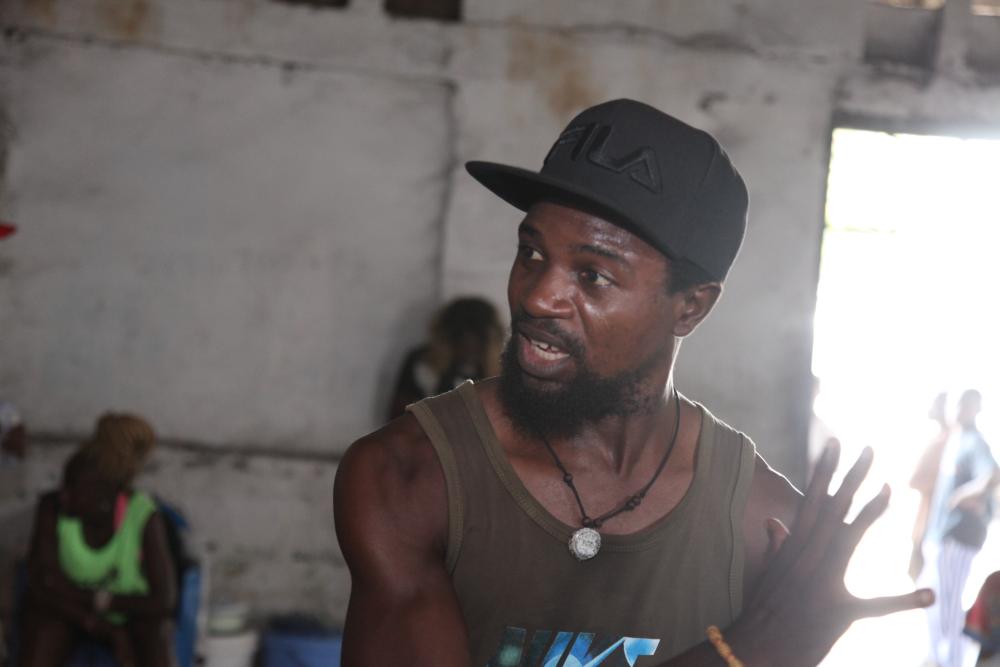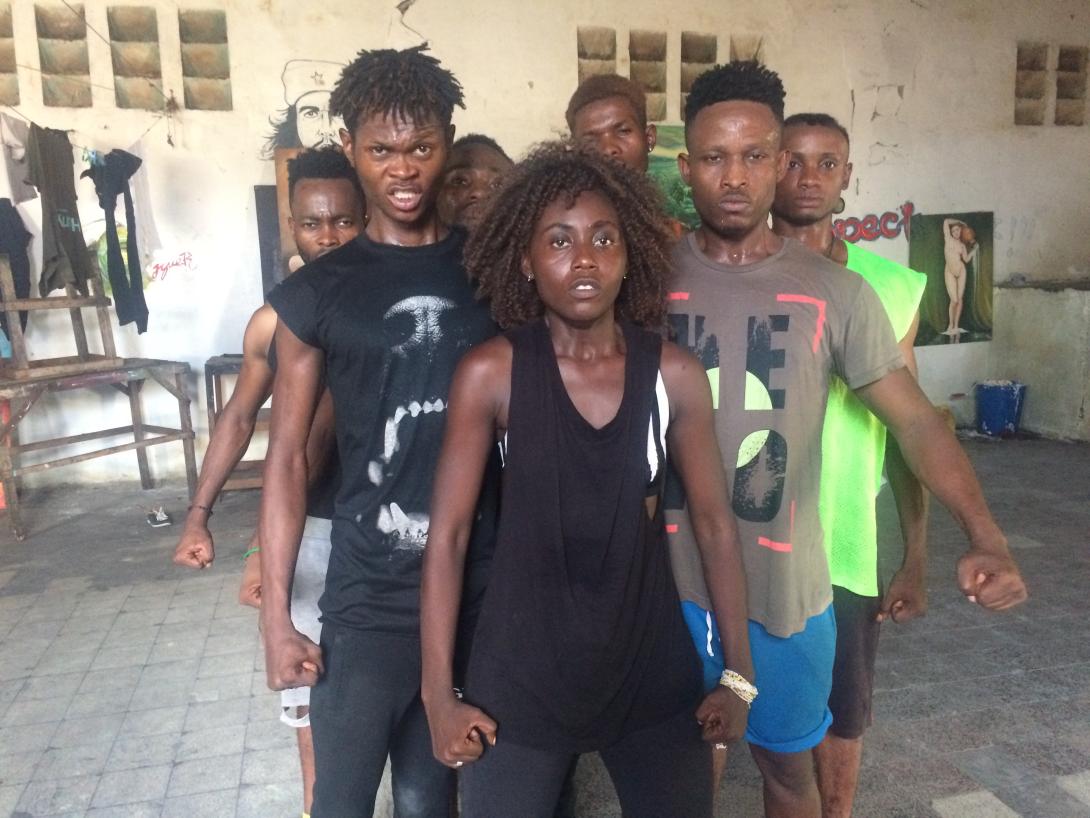‘HERE, IN MY CORNER, I’M THE KING’
A conversation with Pepe Elmas Naswa
A conversation with Pepe Elmas Naswa. This conversation was made possible thanks to Michael Disanka, who conducted the interview for us in Kinshasa.
During Connexion BXL, Pepe Elmas Naswa will present the premiere of his fourth creation. In Dans la peau de l’autre (In the Other’s Skin), he casts a spotlight on the potential of a group of ‘forgotten’ Kinshasan youths. ‘They dance with abandon to overcome the difficulties of their everyday lives – but what is their future?’
Tell us about your first encounter with the snake dance. What was the first time that you found inspiration in the street?
It was a long process that led me to the snake dance, but let’s start from who I am to unravel all the contours of the project. I am a young choreographer from Kinshasa and thanks to the Plateforme Contemporaine, I have had a series of rich encounters with playwrights, choreographers and directors of international fame. From this perspective, I wanted to do something new with contemporary dance, which would be a discovery for me and which would allow me to cast off the yoke of my elders and finally find my own voice. I first encountered the snake dance at a bar in my neighbourhood, “Chez Papa Fololo”, the manager of which regularly organizes events with young people who are socially marginalized because they are scoundrels, street children, and hotheads… The bar is often very rowdy, the beer flows freely, and fights break out over nothing. If you go there, you risk being assaulted. And it was in this world that for the first time, I saw young people energetically dancing the snake dance.
How did the young people react when you suggested that they teach you the dance? And what did they say when you asked them to explain the meaning of the movements?
It was a bit strange for me because I did not feel excluded from the dance. But I did have a lot of questions about the origins of the dance and the attitudes that result from it. It was something that only happened there and not elsewhere. Many of the young people already knew me and that certainly helped our relationship. DJ Samantha is one of the prominent young people with whom I have worked. He was my guide and it was with him that I made the journey to a different world that exists right beside ours. I gradually discovered that this is a dance that developed out of a certain provocative audacity. It expresses an ephemeral joy as if to say ‘I am dancing now and nothing else exists, I am the king here and you are all watching me.’ When I asked them to tell me about what motivated their movements – because the movements always changed – they answered ‘I dance to show that I am superior… or because I want them to know that I am the strongest…’
So it is a provocative dance that says: here, in my corner, I am the king? I imagine that also reflects the situation in which these young people live.
Yes, they think of themselves as baby snakes. They were forced to fend for themselves too early because their parents neglected them. So they find themselves somewhat on the margins of society. The simple fact that they are there is disturbing and the relationships between them are governed by the law of the jungle. They live in constant violence. You can feel the spirit of struggle in this dance, which gives provocation free rein.
How did you integrate the dance into your choreography Dans la peau de l’autre?
First and foremost, I had to preserve the spirit of the dance. As they say themselves: ‘sans esprit, zéro’ (without spirit, there is nothing). So I integrated it into my creative process. Eighteen people took part in a series of exchange workshops with professional and amateur dancers in Kinshasa. At the end of these workshops, I already had some material and I selected two of the eighteen participants, including DJ Samantha, to be part of the production’s cast. We then worked on transforming this material, which allowed us to go beyond the snake dance itself.
Going beyond this dance of survival also led to you integrating other forms of Kinshasan street dancing. How did you do that?
My goal was to bring the reality of this very neglected social group back into the spotlight, to raise questions. They dance with abandon to overcome the difficulties of their everyday lives, but what is their future? Do they have a future? This required a transformation not only of the material that I used, but also of these juvenile delinquents who are called ‘Kuluna’. My production is inspired by this segment of Kinshasan society, so this transformation still had to be infused with the spirit of Kinshasa. That is why I explored other forms of expression, so that I could really integrate the streets of Kinshasa. After seeing my production, I would like people to see these young people in a different way because they are also a constitutive part of Kinshasa.
How do you change this perspective, knowing that they are violent?
When I talk about transformation, I mean that their position needs to change. Some of them have gifts other than violence. You only need to watch them performing the snake dance to understand that. But society has prevented them from developing in any other way. If I can make two young people aware of the fact that they can achieve more through dance and music than with machetes, my work makes sense. I want them to show the world that they are capable of much more than violence.
Have any the youths seen the show? Have you discussed it with them? If not, will you try to show it to them?
No, not yet. The show will première at the Kaaistudio’s in Brussels in December. I hope that the production leads to the return of the snake dance in the place of its birth.
You are a choreographer and a dancer. How did you start dancing yourself?
My background is in the hip-hop movement and I learned to dance while doing it, thanks to the many choreographers that I have met over the course of my career, like Didier Ediho and Faustin Linyekula, and many others both from Africa and elsewhere. I also took part in many workshops organized by the Plateforme Contemporaine in Kinshasa. Dans la peau de l’autre (In the Other’s Skin) is my fourth piece.
I saw that you presented Face à Face 2 at the Masdanza Festival on the Canary Island. Was that production influenced by the snake dance?
Perhaps, but it certainly influenced my writing, which you could call contemporary Afro-Street-Kishasan. In Face à Face 1, I wanted to take the show to the public and perform in the street to question Kinshasan society about conflict because the various positions are too hardened in Kinshasan society, but there is also an unexpressed energy due to the common ground in society. But in Face à Face 2, I return to Congo’s recent history, following the presidential elections in 2011, when two political figures in the DRC each claimed victory and took the presidential oath, followed by clashes between their supporters. And we are still living in a kind of cacophony in Congo today.
In December, you will present Dans la peau de l’autre (In the Other’s Skin) in Brussels during the Connexion Bxl Festival. Is this the first time that you will present your own work in Belgium?
Yes, and I think that this will be the beginning of a new period in my career.

